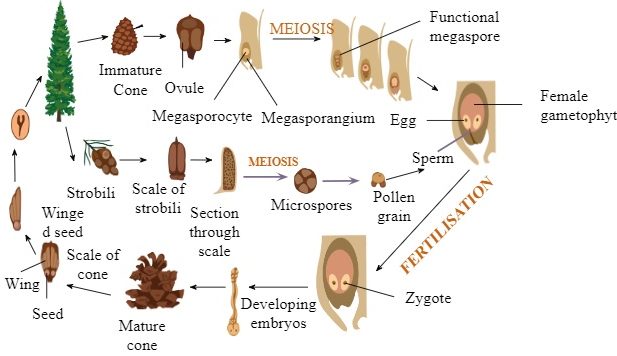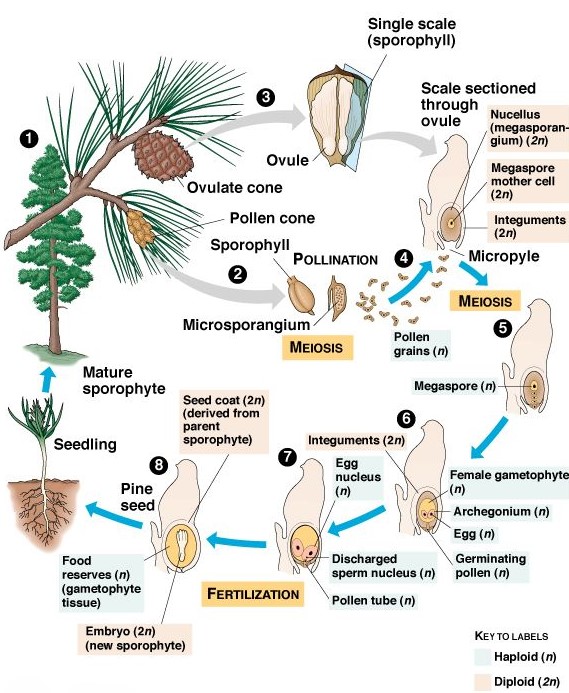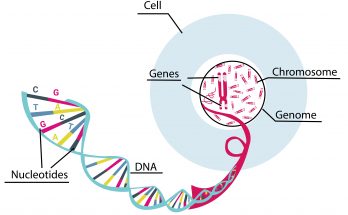The life cycle of gymnosperms, including species like pines and redwoods, features distinct phases from spore formation to seed maturation. Unlike flowering plants, gymnosperms have exposed seeds on cone scales, not enclosed in an ovary. The life cycle begins with the production of male and female spores, which develop into pollen grains and ovules, housed in separate male and female cones. Pollination typically occurs via wind, which transports pollen to ovules. This leads to fertilisation and the development of seeds, each harbouring an embryo capable of growing into a new plant. This process showcases an alternation between the dominant sporophyte stage and a reduced gametophyte stage, enabling gymnosperms to thrive in various environments.
Table of Contents
Gymnosperm Life Cycle- Key Stages and Processes
This section details the specific stages and mechanisms of the gymnosperm life cycle, from spore production to seed development.

Spore Production-
- Heterospory- Gymnosperms produce two types of spores in different structures. Microspores develop into male gametophytes (pollen grains), while megaspores develop into female gametophytes.
- Sporangia and Sporophylls- These spores are produced within sporangia, which are located on sporophylls. The sporophylls are arranged to form cones, also known as strobili. Male and female cones usually appear on the same or different parts of the plant depending on the species.
Pollen Formation-
- Microsporangiate Strobili (Male Cones)- These cones contain microsporangia where the microspores undergo development to become pollen grains. Pollen grains are the carriers of the male genetic material and are adapted for wind dispersal.
- Reduction of Male Gametophyte- The male gametophyte within the pollen grain is reduced to a few cells, a strategy that minimises resource expenditure and enhances dispersal efficiency.
Ovule Development-
- Microsporangiate Strobili (Female Cones)- The female cones contain megasporophylls, which hold the ovules. Each ovule houses a megaspore mother cell.
- Megaspore Development- The megaspore mother cell undergoes meiotic division to produce four megaspores, of which usually only one survives to develop into a female gametophyte.
Pollination and Fertilisation-
- Pollination– Wind carries pollen grains from male cones to female cones, where they land near the ovules.
- Pollen Tube Growth- Once a pollen grain settles on an ovule, it germinates and grows a pollen tube that penetrates the ovule to reach the female gametophyte inside.
- Fertilisation- The pollen tube releases male gametes that fertilise the egg cells in the archegonia of the female gametophyte.
Also Chekc – Why is Double Fertilization in Gymnosperms absent ?
Seed Development-
- From Zygote to Seed- Post-fertilization, the zygote formed within the ovule develops into an embryo. The ovule itself transforms into a seed, containing the new embryonic plant along with stored food resources for germination.
- Naked Seeds- Unlike angiosperms, gymnosperm seeds are not enclosed in fruits; they remain exposed on the surface of the female cone scales.
Seed Dispersal and Germination-
- Dispersal Mechanisms- The seeds are typically dispersed by wind, thanks to their lightweight and sometimes wing-like structures.
- Germination- Upon finding a suitable environment, the seeds germinate, giving rise to new gymnosperm plants that will continue the cycle.
Also Check – 10 Key Differences Between Angiosperms and Gymnosperms
Example- Lifecycle of a Pine Tree
In this section, we explore the lifecycle of a pine tree to illustrate the general principles of gymnosperm development discussed earlier

1. Formation of Cones-
- Stage 1- In mature pine trees (sporophytes), both male and female cones develop, each playing a distinct role in reproduction. Male cones, known as pollen cones, are responsible for producing pollen, while female cones, termed ovuliferous cones, will eventually house and protect the developing seeds.
2. Development of Male Cones-
- Stage 2- Male cones typically appear in clusters underneath the new shoots of the pine tree. These clusters are strategically positioned to facilitate the efficient dispersal of pollen by wind.
- Stage 3- A closer look at a male cone reveals that it is composed of multiple fertile scales arranged in a spiral pattern around a central axis or stalk. This arrangement maximises the surface area for pollen production.
- Stage 4- A longitudinal section through one of these fertile scales shows two adjacent pollen sacs. Within these sacs, cells called sporocytes undergo meiosis, a type of cell division that reduces the chromosome number by half, resulting in the formation of haploid microspores.
3. Pollen Grain Development-
- Stage 5- Within the confines of the pollen sacs, the microspores begin to develop into pollen grains. As they mature, each microspore is encased in a thick wall. This wall features two distinct air-filled sacs that aid in buoyancy and ensure the pollen can be easily carried by wind.
- Stage 6- Eventually, the developing microspores separate from one another, with each now a distinct, single-celled, haploid pollen grain. These grains are genetically diverse, each carrying a unique set of genetic information from the parent plant.
- Stage 7- Once mature, these pollen grains, each containing four cells, are released from the male cones. Carried by air currents, they travel towards female cones, which are often located on different trees to promote genetic diversity.
4. Development of Female Cones-
- Stage 8- Female cones develop near the tips of the branches, usually higher up in the tree and often surrounded by protective leaves. This positioning helps protect the developing seeds from herbivores and environmental stress.
- Stage 9- A longitudinal section through a female cone would show the fertile scales arranged spirally around the central axis, similar to the male cones. However, during the pollination period, these scales slightly separate to create gaps that capture and channel pollen towards the ovules contained within.
5. Ovule and Pollen Interaction-
- Stage 10- Each fertile scale on the female cone typically supports two ovules on its upper surface. These ovules feature a small opening called the micropyle. During pollination, the micropyle traps pollen grains with a sticky droplet that exudes from each ovule. The trapped pollen grains, aided by their air-filled sacs, float through this micropyle to reach the surface of the female sporangium within the ovule.
6. Fertilisation Process-
- Stage 11- Inside the ovules located on the female cones, each contains a sporangium wherein special cells known as sporocytes are found. These cells are crucial for the next step of reproduction.
- Stage 12- Sporocytes undergo meiosis, a cell division process that halves the chromosome number, producing four haploid cells called megaspores. Out of these, only one megaspore remains viable while the others degenerate. This surviving megaspore will develop into the female gametophyte.
- Stage 13- The functional megaspore then grows and divides, forming a multicellular female gametophyte inside the ovule. This structure will eventually house the egg cells that are critical for reproduction.
- Stage 14 & 15- Meanwhile, pollen grains that have been captured by the ovules begin to germinate, growing a structure called a pollen tube. This tube penetrates the female gametophyte to reach the egg cells located in structures called archegonia. Sperm cells are released from the pollen grain through the pollen tube and fertilise the egg cells, forming a zygote.
7. Embryo Development-
- Stage 16 & 17- Following fertilisation, the zygote undergoes division to form multiple cells. These cells differentiate and some develop into suspensor cells, which help push the developing embryo deeper into the nourishing tissue of the gametophyte. This process can result in the formation of multiple embryos, but typically only the most robust embryo survives and continues to develop.
- Stage 18- The surviving embryo matures and begins to form essential plant structures such as the root tip, shoot tip, and cotyledons (the first leaves).
8. Seed and Cone Maturation-
- Stage 19- As the embryos develop within the ovules, these structures mature into seeds. Concurrently, the female cones that house these seeds become woody and the scales close tightly to protect the developing seeds.
9. Seed Dispersal-
- Stage 20- When the seeds are fully mature, the female cones open up. This exposes the seeds, each typically equipped with a papery wing formed from the ovule’s integument, aiding in their dispersal by wind.
- Stage 21- The winged seeds are carried away from the parent tree by the wind, ensuring that they spread over a wide area and find suitable conditions for germination.
10. Germination-
- Stage 22- Upon landing in a suitable environment with the right soil conditions, the seeds germinate. During germination, the seed breaks open, and the embryo uses the stored nutrients to grow roots, a stem, and cotyledons. These cotyledons will initially provide the nutrients required until the plant can begin photosynthesis on its own.
Also Check – Angiosperms- Characteristics, Classification, and Reproductive Biology


